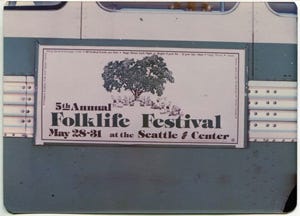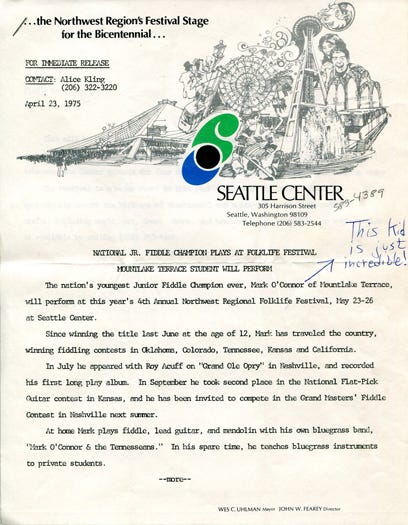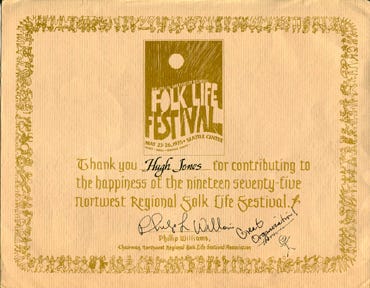The Record Store Years 5) Before the Record Store, Directing the Folklife Festival
A memoir of 25 years (1975-2000) spent working in the world of records & music in Seattle, with occasional side trips into writings on Led Zeppelin and other adventures from my musical life.
I arrived in Seattle in July 1974 and after a few weeks of coasting on money sent from my parents, I buckled down to job-hunting and came up with a gig working for a government program known as VISTA (Volunteers in Service to America). It was sort of a domestic Peace Corps program, providing volunteer labor for non-profit organizations free of charge, and paying the volunteers a basic wage of $200 plus about $50 worth of food stamps per month, for a term of one year.
I was living in the basement of a U-District rooming house owned by the YMCA, first in a tiny, windowless room for $45 per month and eventually a larger room with a window for $65 per month. Believe it or not Seattle was a very inexpensive place to live in the mid-1970s, and the $250 per month allowed me to live comfortably with even a little money left over for buying a record now and then.
The first non-profit I landed with was called REACH, and they provided services for elderly people in the community such as entertainment programs in care facilities. My job included coordinating music events for the ‘old folks homes,’ organizing a small group of musicians and booking them into various facilities and then driving them to & from the gigs and providing general support. It was fun and I enjoyed the people I worked with – especially a young woman with long blonde hair named Lesley who was also in the VISTA program, and came on board at REACH to set up a crafts program.
Unfortunately, REACH went out of business a few months after I started due to embezzlement by an unscrupulous member of their board. The silver lining for me and Lesley was that there were other people on REACH’s board – specifically Phil and Vivian Williams - who were also on the board of the Northwest Regional Folklife Festival, then going into its fourth successful year as a major event held on Memorial Day Weekend at the Seattle Center.
Lesley and I had only satisfied a few months of our one-year VISTA commitment at this point and the Folklife Festival was also run as a non-profit organization, so when the board members realized that they could have us for free they suggested that we could be co-directors of the 1975 Festival. It sounded like a good idea to us, so we accepted.
Above: From the festival brochure, give us a call!
Looking back, I am still amazed at how casual the whole thing was. The festival was already a pretty big deal, attracting close to 200,000 people over a four-day weekend and garnering in-kind services from Seattle Center and financial support for the 1975 event to the tune of $9500 from SeaFirst Bank, Rainier Brewery and the City of Seattle based on the success of the previous three festivals (that’s about $55k in 2024 dollars). Despite this, in January of ’75 they had no one lined up to direct the event and decided that two teen-aged hippies from the east coast could do the job. I’m not sure why they thought we could do it, but I suspect that some of the REACH people were aware that we were trustworthy and doing a good job there, so they must have recommended us.
Above: The directors of the fourth annual Northwest Regional Folklife Festival, summer 1975
And so it was that in January of 1975 we were given an office on the lower level of the Seattle Center ‘Center House’ with two desks, two chairs and a telephone. Phil and Vivian introduced us to a handful of people that had been involved in helping with the previous festivals and gave us a box of 3” by 5” index cards containing the names and phone numbers of the musicians, dancers and craftspeople who had participated in the event before.
With support (but minimal oversight) from the board, we spent our days in the office calling those phone numbers and booking people into slots on the various stages around the grounds and coordinating various aspects of the festival with our volunteer helpers and the Seattle Center. Led Zeppelin’s Physical Graffiti album had just come out and I had a little Radio Shack cassette player on my desk and played a tape of it constantly. Occasionally some long-haired folkie would come into the office with a demo tape (or an instrument) asking if they could get a spot in the festival, and we usually accommodated them. It was what you might call a chill situation!
The hardest part of setting up and running the festival was dealing with the Seattle Center bureaucracy. It was a typical city government department, run by older ‘professionals’ who didn’t think much of the Folklife Festival board’s choice of directors – we were not made to feel welcome, and encountered endless roadblocks to setting things up and having them run smoothly.
Above: Advertisement on the side of a Metro bus, spring 1975
As it turned out we eventually found a most unlikely ally from the Seattle Center staff in their head of security, an authoritative and somewhat taciturn character named Lieutenant Fraley. After banging our heads against the wall trying to get beer for participants, pianos on certain stages, sound technicians to run the performances and other things that required clearance and support from the powers that be, we figured out that the one person who could grease the wheels for all of it was Lt. Fraley, and fortunately he decided that we were ok. After hearing of our travails he agreed to help us, and engineered work-arounds for pretty much every roadblock we encountered right up until and during the four days of the event.
Long story short, the festival was a resounding success. Among the many highlights for attendees was a dance performance by the Tlingit Indians, who traveled to the festival from Sitka Alaska and were put up in the downtown Seattle YMCA. It was their first trip to the lower 48 and these were people unfamiliar with indoor plumbing, much less the concept of an elevator, and they spent hours riding the Y’s lifts up and down for enjoyment. Their dance performance at the Opera House on Sunday night was stunning.
Also booked at the festival was Mark O’Connor, who at the time was a 13-year old fiddling phenom, winning old-time fiddle contests all over the country and making high profile appearances such as appearing with Roy Acuff at the Grand Ole Opry in Nashville.
Above: One of the many press releases we sent out in advance of the festival. This is a copy that I sent to my parents back east, with a notation in the margin.
My most enduring memory of the festival is witnessing an after-hours jam session in the participant’s lounge, which was set up in one of the Northwest rooms of Seattle Center. The spectators had all gone home and the musicians were drinking beer, shooting the breeze and playing bluegrass to beat the band. Mark O’Connor was the center of attention, not playing fiddle but flat-picking an old Martin guitar – and absolutely killing it. The solos would go around the room, bluegrass style, and every time Mark’s turn came he got hotter and hotter – I was absolutely blown away – and that performance remains among the best live music experiences of my life, and the root of an appreciation for bluegrass that sustains to this day.
Mark O’Connor went on to fame and fortune, Lesley went on to direct the Folklife Festival again the following (bicentennial) year with even more funding and success, and I went on to land my ‘dream job’ at The College of Musical Knowledge – Cellophane Square Records.
NEXT: The ‘Dream Job’ Begins









Great stories Hugh!
Hi Hugh! This is Peggy who lived in the YMCA house with you. We called it “The Projects.” My brother, Ron (Skip) lived in the penthouse “suite” upstairs. Do you remember me? We used to go camping in my 1958 VW bug. You and I went to a Led Zeppelin concert at the Coliseum and almost got trampled. We missed the bus back to the U District and walked back. I remember Lesley as being a lovely person. I live in Ocean Shores now. I think of you often with fondness. Those were some good memories.